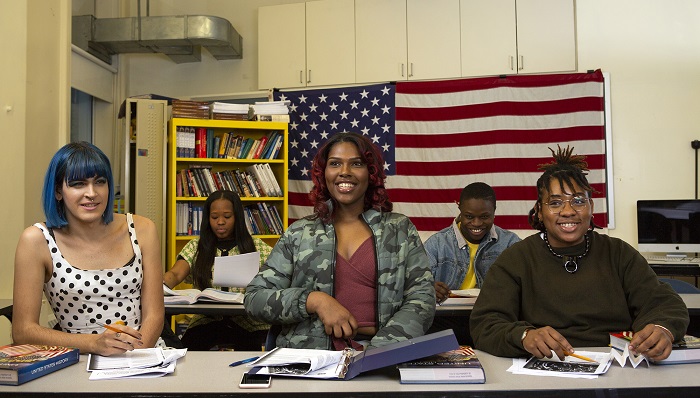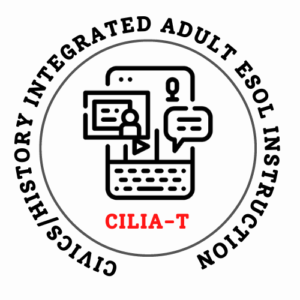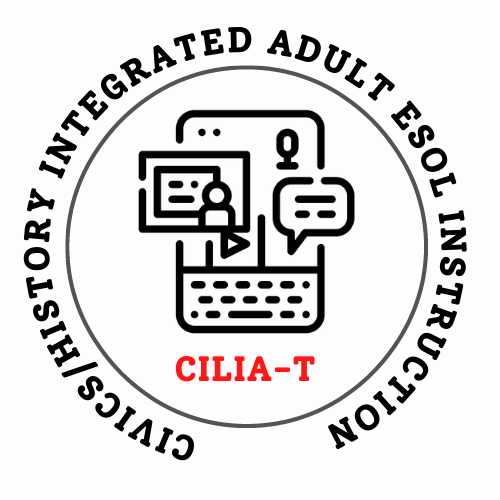- MN ABE Connect
- Archive
- Civics/History Curriculum: An Introduction to the CILIA-T Curriculum Project
 March 28, 2022
March 28, 2022
Civics/History Curriculum: An Introduction to the CILIA-T Curriculum Project
Erin Cary, UMD CILIA-T Research Coordinator & ELL Instructor Aydin Durgunoglu, CILIA-T Project LeaderWhat makes a resource “teachable”, and what tells you that it just won’t work? How many instructional needs can one curriculum meet, and how ambitious should one curriculum try to be?
We have been pondering and discussing these questions and many more lately, as a team working on the CILIA-T curriculum project.
 CILIA-T stands for Content-Integrated Language Instruction for Adults with Technology Support. Funded by the Institute for Education Sciences, this five-year project will build and pilot a standards-aligned, 16-module curriculum designed for intermediate-level adult English learners to broaden their academic vocabulary, morphological skills, and critical thinking application while engaging U.S. history and civics content through a thematic lens. Students will also build and practice digital literacy skills using this resource, which will be teachable in person and via hybrid and remote delivery models, both on computers and mobile devices. The best news for educators: the entire curriculum will be available online for free.
CILIA-T stands for Content-Integrated Language Instruction for Adults with Technology Support. Funded by the Institute for Education Sciences, this five-year project will build and pilot a standards-aligned, 16-module curriculum designed for intermediate-level adult English learners to broaden their academic vocabulary, morphological skills, and critical thinking application while engaging U.S. history and civics content through a thematic lens. Students will also build and practice digital literacy skills using this resource, which will be teachable in person and via hybrid and remote delivery models, both on computers and mobile devices. The best news for educators: the entire curriculum will be available online for free.
Curriculum structure
Each module will consist of two 90-minute in-class lesson plans, plus roughly one hour of independent online practice for students. Currently in early stages of development, all modules will include the following:
- content and skills-based objectives
- thematic guiding questions
- opportunities for community-building discussion/story-telling and stimulation of background knowledge
- multiple readings of a central text with a focus on U.S. history and civics topics and data
- practice with targeted domain-specific and transferable academic vocabulary and related morphology
- comparative/counternarrative engagement with additional materials (images, videos, graphic organizers incorporating data or statistics, maps, texts, quotes, etc.)
- critical analysis activities like evaluating sources, considering bias, fact vs. opinion, etc.
- project-/problem-based projects for individuals and groups
- review activities
- lots of opportunities for students to apply their life experiences to the class discussion and transfer learning to their own daily lives
Each module connects U.S. history and civics to current events, and makes space for students to shape the conversation. There will be teacher resources and videos available so that the curriculum can be used by teachers with various levels of experience.
Project leadership and input
The project is led by Aydin Durgunoglu (University of Minnesota Duluth), Daphne Greenberg and Elizabeth Tighe (Georgia State University), and Theresa Sladek (Literacy Minnesota). An exciting feature of the CILIA-T project is the strong representation of active teacher and student voices in shaping the curriculum as it is written and piloted over the next few years. Experienced adult educators in civics, U.S. history, English language instruction and digital literacy, many currently teaching in adult education settings, are collaborating on initial draft versions of the modules, and our team will gather and incorporate input from teachers and learners during our pilot, starting in 2023.
In fact, we’re already shaping our curriculum using input from the field! As our project team begins drafting CILIA-T modules, Erin recently spoke with 14 educators in various roles in adult education in MN and GA to gather their ideas for pros and cons that go into selecting curriculum resources. Erin met with professional instructors currently teaching online, in person and hybrid classes for community-based, college-based and school district programs, lead teachers, administrators, and volunteer teachers.
After walking through our project, Erin asked them what features might make them excited to try out a U.S. history/civics curriculum resource, and what barriers or drawbacks might discourage them from adopting a resource. Here’s what our brilliant colleagues had to say!
General/overall responses
Educators preferred teaching resources that:
-
- are designed explicitly for adult learners, rather than K-12 or college students
- are student-driven and prompt thought-provoking discussion, including ways for learners to connect their extensive knowledge and life experiences to the lesson
- are systematic and well-structured, with lots of teacher support for professional instructors and especially for volunteer instructors
Educators would NOT CHOOSE teaching resources that:
-
- aren’t standards-aligned
- lack academic rigor or relevant academic vocabulary
- are misaligned for the intended level or don’t provide adequate repetition and practice
- try to cover way too much
- are impossible to adapt for different groups/schedules, or won’t benefit students with more occasional attendance
Content-related responses
Educators preferred teaching resources that:
-
- are thematic and open learners up to engagement, rather than narrow historical overviews or ephemeral news topics
- incorporate social justice themes and foster self-advocacy and leadership
- use primary and authentic texts (well-supported for the level)
- include some explicit skill-building and knowledge-building toward learners’ GED/diploma and/or citizenship goals
Educators would NOT CHOOSE teaching resources that:
-
- aren’t relevant to students’ lives, interests and goals
- are too jingoistic or tend to perpetuate received notions or mythologies about U.S. history without critical engagement
Digital access-related responses
Educators preferred teaching resources that:
-
- are interactive and can be mastered quickly by learners
- use flexible technological options that are easy and cost-free for programs to access
- have had any independent student work approved through the Teacher Verification Model and made countable as time-on-task proxy hours
- rely on tech tools that are likely to remain available to teachers and learners for a long time
Educators would NOT CHOOSE teaching resources that:
-
- require too much time spent on logins, switching between platforms, or supporting learners on digital logistics alone instead of lesson content
- are only available via downloadable apps rather than on the web
- don’t properly support instructors in how to guide students on using digital tools
Next steps
This fabulous input has already guided the content team for the CILIA-T project to frame units more thematically, consider how to engage learners as authentically as possible with the content and use of digital tools, and connect curriculum to their real-life needs and goals. Many thanks to our colleagues for the advice and perspective provided!
Next steps in the CILIA-T project include drafting modules with the help of practicing educators; testing the effectiveness of different approaches; pre-assessing learner skills related to the curriculum to inform expectations; and consulting with expert colleagues to make sure our history is accurate and relevant, and that we incorporate culturally responsive approaches and instructional best practices.
Keep up with our project via future MN ABE Connect articles coming your way (and stay tuned for the debut of our forthcoming website)! Follow our social media to share your favorite resources and teaching ideas, and follow our progress–let’s keep in touch!
Emails: [email protected] and [email protected]
Facebook: https://www.facebook.com/CILIAT21
Twitter: @CILIATech
Instagram: @CILIATech

Newsletter Signup
Get MN ABE Connect—the official source for ABE events, activities, and resources!
Sign UpArticle Categories
- ABE Foundations/Staff Onboarding
- ACES/Transitions
- Adult Career Pathways
- Assessment
- CCR Standards
- Citizenship
- COVID-19
- Cultural Competency
- Digital Literacy/Northstar
- Disabilities
- Distance Learning/Education
- ELA
- Equity/Inclusion
- ESL
- HSE/Adult Diploma
- Listening
- Math/Numeracy
- Mental Health
- Minnesota ABE
- One-Room Schoolhouse/Multilevel
- Professional Development
- Program Management
- Reading
- Remote Instruction
- Science
- Social Studies
- Speaking/Conversation
- Support Services
- Teaching Strategies
- Technology
- Uncategorized
- Volunteers/Tutors
- Writing